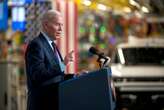Today, Amazon announced that it had met a goal to run on 100% renewable electricity seven years early. But a group of Amazon employees argues that the company’s math is misleading.
A report from the group, Amazon Employees for Climate Justice, argues that only 22% of the company’s data centers in the U.S. actually run on clean power. The employees looked at where each data center was located, and the mix of power on the regional grids—how much was coming from coal, gas, or oil versus solar or wind.
Amazon, like many other companies, buys renewable energy credits (RECs) for a certain amount of clean power that’s produced by a solar plant or wind farm. In theory, RECs are supposed to push new renewable energy to get built. In reality, that doesn’t always happen. The employee research found that 68% of Amazon’s RECs are unbundled, meaning that they didn’t fund new renewable infrastructure, but gave credit for renewables that already existed or were already going to be built.
Amazon did not immediately respond to a request for comment.
As new data centers are built, they can mean that fossil-fuel dependent grids end up building new fossil fuel power plants. “Dominion Energy, which is the utility in Virginia, is expanding because of demand, and Amazon is obviously one of their largest customers,” says Eliza Pan, a representative from Amazon Employees for Climate Justice and a former Amazon employee. “Dominion’s expansion is not renewable expansion. It’s more fossil fuels.”
Amazon also doesn’t buy credits that are specifically tied to the grids powering their data centers. The company might purchase RECs from Canada or Arizona, for example, to offset electricity used in Virginia. The credits also aren’t tied to the time that the energy was used; data centers run all day and night, but most renewable energy is only available some of the time.
The employee group argues that the company should follow the approach that Google takes. Google aims to use carbon-free energy, 24-7, on every grid where it operates.
Of course, every tech company is now facing an even bigger challenge: meeting the enormous energy demand from AI. Microsoft’s energy use has jumped up by about 30% since 2020, thanks to AI. Google’s emissions have grown by nearly 50% since 2019. That makes it even more important that companies have the right goals and communicate progress honestly, Pan says. “The 100% renewable announcement is a distraction,” she says. “It makes people think, oh, Amazon’s doing great, when actually there are these real challenges like the growth of AI. Really, sustainability needs more resources and more prioritization.”









No comments